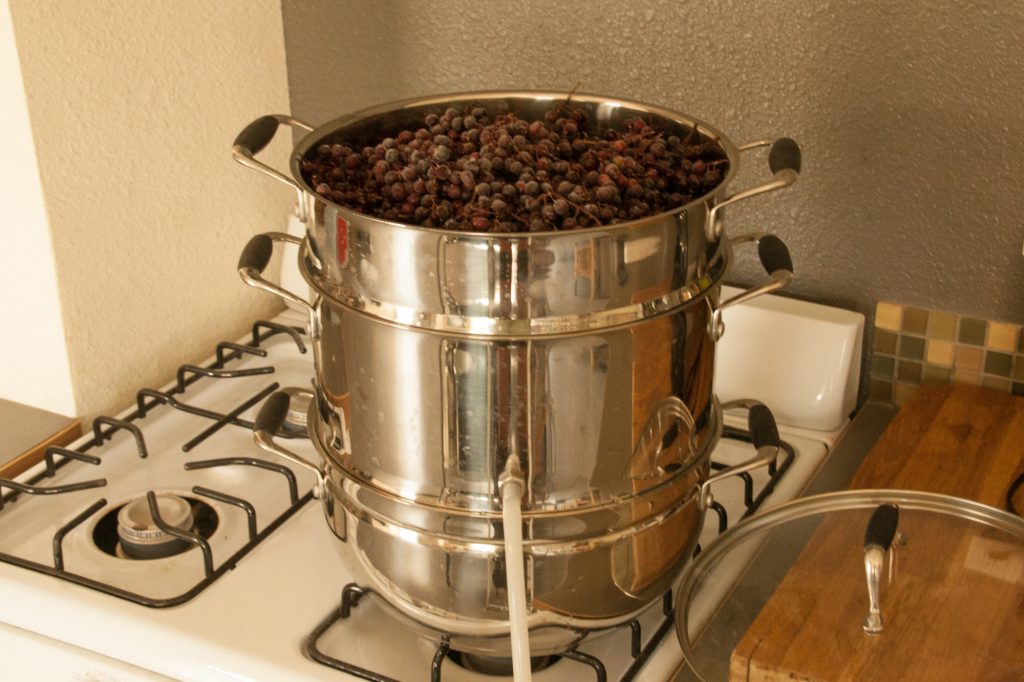
I was in the middle of writing a post about Concord grapes, when I realized that anyone serious abut making quantities of fruit juice probably needs to know about one of my favorite tools: a steam juicer.
For years I juiced fruit in a large sauté pan, barely covering the fruit with water, simmering until it was soft, then straining the juice through a jelly bag. Then one year at the Midwest Wild Harvest Festival, my pal Bill Cook casually mentioned that when he had large quantities of fruit to juice, he used a steam juicer. I’d never heard of such a thing, but since I love kitchen gadgets and labor saving devices, it didn’t take much convincing before I was placing my order on Amazon.
A steam juicer has three parts. On the bottom is a solid pan that holds water. In the middle is a pan that resembles a Bundt pan, with a cut out in the middle. This pan also has an outlet to which a piece of translucent tubing is attached.

The top pan is partially perforated on the sides and bottom. Most models have glass lids, which allow you to watch the progress of your fruit; some less expensive models have a metal lid.

The beauty of a steam juicer is that the steam does all the work. You fill the bottom pan about 3/4 of the way with water (the instructions for your specific model will give you precise measurements), place the empty middle pan on top of that, then place the top pan on top of the middle pan, and fill it with fruit. Put on the lid, turn on the heat, and wait for the magic to happen.

As steam rises up through the center hole of the middle pan and through the perforations of the top pan, it breaks open the skins of the fruit and the juice drips down through the perforations into the middle pan. (Note: the top pan is not perforated directly above the hole of the middle pan. This keeps the juice from dripping down into the water.)
As juice collects in the second pan, you’ll see it fill the tubing. Squeeze the metal clasp that keeps the tubing closed to release the juice into a storage vessel.
It takes about three hours to juice a full pan of fruit. So no, it isn’t super fast, but it saves you the trouble of cooking the fruit in batches, transferring each batch to a jelly bag, and waiting for the juice to strain. With a steam juicer, you can pretty much just check in every 30 minutes to collect the juice.
Once I’ve finished juicing, I take the pulp from the top of my steam juicer and run it through a food mill to remove any seeds. Then, I sweeten the pulp just a little, and make fruit leather. Works great with crabapples, chokecherries, plums, grapes, prickly pears, and probably lots of other fruits I haven’t tried yet.
Do you NEED a steam juicer? At about $150, it’s a splurge. So start saving up. Or drop a hint to someone who’ll be giving you a present in the next few months. It’s one of my favorite kitchen tools and I highly recommend it.
Do you think this would work with pomegranates?
Do you think this will work with pomegranates?
Yes, I think it would! Please let me know if you try it.
Thanks! Poms won’t be around till the fall, so it will be a while!
Now if I can only find an easy way to get all those arils out! 🙂
The beauty of the steam juicer is that you won’t have to worry about the arils. The steam releases the juice into the bottom compartment of the juicer and leaves the bare arils behind in the top basket. It will make your life so much easier!
Where does one find a source for the steam juicer?
In the first sentence of the post there’s a link to the model I bought for myself. Click on the words “steam juicer” in green and you’ll be able to read about the item on Amazon.
Ace Hardware stores usually have them during canning season. I purchased one from Amazon, which will give you a larger selection. Juicing apples gets you juice and applesauce. I add some of the juice back into the applesauce. Red crabapples are especially good for applesauce!
I do exactly the same thing with crabapples!
In reply to John asking where to get a steam juicer,
I live near Australia and I bought mine from Lehman’s Non-electrical store in America. The price was OK considering they import them. The steamer was well packed and I have been using it for over 10 years now. I still love the concept because the flavorsome juice is pre-sterilised hence few worries about it going mouldy on storage. Nonetheless, I prefer to put a little liquid coconut oil on top of the juice when bottled to seal it some more besides your normal way of capping. Coconut oil sets hard when cool, and is easy to remove when wanting to get the juice out of the bottle.
Would this work to make white clover jelly?
I’ve never made white clover jelly and honestly, I don’t think white clover has a strong enough flavor to make it worthwhile. The jelly would probably just taste sweet. But if you do go ahead, no need for a steam juicer. Those are primarily useful for fruit and vegwith heft. For something delicate like white clover you don’t want to apply so much heat for such a long time. Just make a strong tea, then use the strained liquid as your jelly base.